|
|
|
Sort Order |
|
|
|
Items / Page
|
|
|
|
|
|
|
| Srl | Item |
| 1 |
ID:
123104
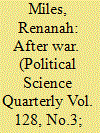

|
|
|
|
|
| Publication |
2013.
|
| Summary/Abstract |
RENANAH MILES examines recent stabilization and reconstruction missions in Afghanistan and Iraq. She analyzes persistent shortfalls in the ability of the State Department and the U.S. Agency for International Development to conduct these missions. She contends that organizational culture and bureaucratic turf wars undermine civilian leadership and encourage the military to compensate in its absence.
|
|
|
|
|
|
|
|
|
|
|
|
|
|
|
|
| 2 |
ID:
115276
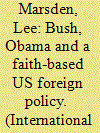

|
|
|
|
|
| Publication |
2012.
|
| Summary/Abstract |
In a calculated move to appeal to his core constituency during his first term, President George W. Bush launched domestic and international faith-based initiatives designed to leverage public finance for religious groupings to carry out social and welfare functions formerly performed by government or secular organizations. In December 2002 the Center for Faith-Based and Community Initiatives (CFBCI) was extended to the United States Agency for International Development (USAID). The Center's intention was to 'create a level playing field' for faith-based and community groups to compete for foreign assistance funding. These presidential initiatives are problematic, however, calling into question the first amendment-the separation of church and state. Upon taking office Barack Obama set up the Office of Faith-based and Neighborhood Partnerships, promising a greater emphasis on community/neighbourhood programs. The CFBCI remains a fixture in USAID and Obama shows as much enthusiasm for the initiative as his predecessor. Faith-based international relations and political science scholars have sought to build on these initiatives and call for a greater role for faith in US foreign policy. On the eve of the 2012 presidential election, this article considers the claims for a faith-based foreign policy by examining the construction of a faith-based discourse by academics and successive presidents. Using faith-based initiatives and USAID as a case-study, the article discusses criticisms of the policy and focuses on the role of a conservative evangelical organization, Samaritan's Purse, to illustrate the advantages and disadvantages of faith-based approaches. The article argues that advocates of faith-based foreign policy, in seeking special privileges for ecumenical religious actors, overlook their declining international significance and the opportunities afforded to less tolerant but more populist religious actors which have the potential seriously to harm US foreign policy objectives.
|
|
|
|
|
|
|
|
|
|
|
|
|
|
|
|
| 3 |
ID:
050915
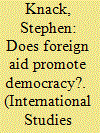

|
|
|
| 4 |
ID:
119945
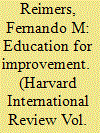

|
|
|
| 5 |
ID:
076882


|
|
|
|
|
| Publication |
2007.
|
| Summary/Abstract |
We model foreign-aid-for-policy deals, assuming that leaders want to maximize their time in office. Their actions are shaped by two political institutions, their selectorate and winning coalition. Leaders who depend on a large coalition, a relatively small selectorate, and who extract valuable policy concessions from prospective recipients are likely to give aid. Prospective recipients are likely to get aid if they have few resources, depend on a small coalition and a large selectorate, and the policy concession sought by the donor is not too politically costly. The amount of aid received, if any, increases as the recipient leader's coalition increases, the selectorate decreases, the issue's salience increases, and the domestic resources increase. The theory explains why many Third World people hate the United States and want to live there. Empirical tests using the U.S. Agency for International Development data for the post-World War II years support the model's predictions.
|
|
|
|
|
|
|
|
|
|
|
|
|
|
|
|
| 6 |
ID:
097806
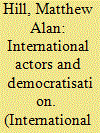

|
|
|
|
|
| Publication |
2010.
|
| Summary/Abstract |
Externally driven state-building is a complicated task that rarely fulfils the declared objectives of the international actors or the local state and society. This paper critiques the international dimension to state-building by examining USAID in Afghanistan and identifying the theoretical and practical explanations for its failure to aid democratic consolidation. Arguing that the Bush administration's democratisation efforts have had a negative impact on consolidating democracy, this paper identifies the democratic product of Afghanistan as characterised, at most, by having the formal institutions, routines and procedures of a democracy. I suggest that this merely 'formal' democratic product is too short-term and fails to take fully into account the need to develop a political and social culture capable of supporting democratic institutions. In terms of the future of democracy promotion in US foreign policy, I suggest that a change of emphasis may be occurring in the Obama administration.
|
|
|
|
|
|
|
|
|
|
|
|
|
|
|
|
| 7 |
ID:
193499
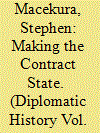

|
|
|
|
|
| Summary/Abstract |
Robert Nathan was not the most prominent figure in U.S. President Franklin Roosevelt’s wartime cabinet, but he got a taste of the public spotlight in April 1942 when Life magazine ran a profile of him. The journalist Joseph Thorndike, Jr. followed Nathan through a typical week in Washington, D.C. Thorndike lauded Nathan’s jocular personality and modest lifestyle. Photographs accompanying the article showed Nathan exercising in a boxing ring and preparing a pancake breakfast at home. What most impressed Thorndike, though, was the thirty-five-year-old economist’s statistical analysis and planning work for the U.S. government. Nathan, an ardent New Dealer, provided crucial research in the administration’s pioneering efforts to craft national income estimates during the 1930s. In January 1942, he joined the War Production Board. Wielding charts and graphs as weapons in fierce debates over how best to mobilize for the war, he made calculated projections of how to boost defense production while preventing another domestic depression. In Thorndike’s telling, Nathan was a patriotic public servant who used his statistical acumen to help fight the Great Depression and World War II.
|
|
|
|
|
|
|
|
|
|
|
|
|
|
|
|
| 8 |
ID:
167837
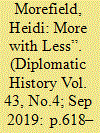

|
|
|
|
|
| Summary/Abstract |
In the aftermath of the 1970s, the United States’ foreign assistance program posed a particular challenge to free-market policymakers. For Peter McPherson, senior consultant to the presidential campaign of then-Governor Ronald Reagan in the spring of 1980, the question of how to optimize aid would be crucial to rethinking U.S. bilateralism. In a report envisioning “A Cheaper and More Effective Foreign Aid Program,” he argued that “the U.S. foreign aid program should be changed to emphasize self-help and technology transfer rather than resource transfer. Studies have shown a higher ‘rate of return’ for ‘investments’ in the self-help/technology transfer programs.” The change in emphasis, McPherson continued, would be consistent with the emerging ideology of Reaganism, although the presidential hopeful should still be “sensitive to the fact that U.S. business provides most of the goods included in resource transfers.”
|
|
|
|
|
|
|
|
|
|
|
|
|
|
|
|
| 9 |
ID:
071086
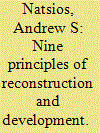

|
|
|
| 10 |
ID:
139474
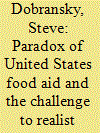

|
|
|
|
|
| Summary/Abstract |
This article analyzes United States food aid from 1981-2009, examining the primary donor motivations and the overall effects on the recipients.
|
|
|
|
|
|
|
|
|
|
|
|
|
|
|
|
| 11 |
ID:
126128
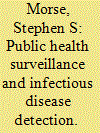

|
|
|
|
|
| Publication |
2012.
|
| Summary/Abstract |
Emerging infectious diseases, such as HIV/AIDS, SARS, and pandemic influenza, and the anthrax attacks of 2001, have demonstrated that we remain vulnerable to health threats caused by infectious diseases. The importance of strengthening global public health surveillance to provide early warning has been the primary recommendation of expert groups for at least the past 2 decades. However, despite improvements in the past decade, public health surveillance capabilities remain limited and fragmented, with uneven global coverage. Recent initiatives provide hope of addressing this issue, and new technological and conceptual advances could, for the first time, place capability for global surveillance within reach. Such advances include the revised International Health Regulations (IHR 2005) and the use of new data sources and methods to improve global coverage, sensitivity, and timeliness, which show promise for providing capabilities to extend and complement the existing infrastructure. One example is syndromic surveillance, using nontraditional and often automated data sources. Over the past 20 years, other initiatives, including ProMED-mail, GPHIN, and HealthMap, have demonstrated new mechanisms for acquiring surveillance data. In 2009 the U.S. Agency for International Development (USAID) began the Emerging Pandemic Threats (EPT) program, which includes the PREDICT project, to build global capacity for surveillance of novel infections that have pandemic potential (originating in wildlife and at the animal-human interface) and to develop a framework for risk assessment. Improved understanding of factors driving infectious disease emergence and new technological capabilities in modeling, diagnostics and pathogen identification, and communications, such as using the increasing global coverage of cellphones for public health surveillance, can further enhance global surveillance
|
|
|
|
|
|
|
|
|
|
|
|
|
|
|
|
| 12 |
ID:
075086
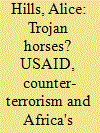

|
|
|
|
|
| Publication |
2006.
|
| Summary/Abstract |
The purpose of US foreign assistance has shifted in the wake of 2001, and Washington has resurrected practices previously associated with police aid during the Cold War. In particular, the Bush administration has broadened the remit of the United States Agency for International Development (usaid) in such a way as to make it a quasi-security agency. The consequences of this could be significant for both usaid and democratic-style police assistance programmes more generally, for today's threat-driven policies are part of a trend which in the past has had worrying consequences. Using the critical variable of public policing (which is illustrated by reference to developments in Kenya), I argue that using usaid to improve the counter-terrorist capacity of Africa's police in the pursuit of US national security objectives is a seriously flawed strategy.
|
|
|
|
|
|
|
|
|
|
|
|
|
|
|
|
| 13 |
ID:
139065


|
|
|
|
|
|
|
|